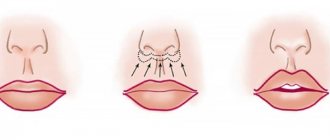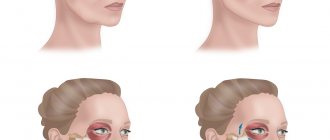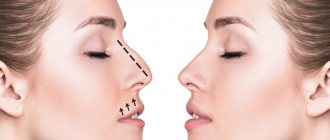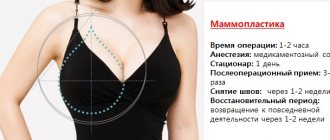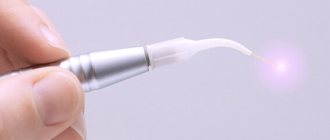What is otoplasty
This is a surgical procedure that helps correct the shape and structure of the ears. This part of the body can be deformed for various reasons. They can be congenital or acquired. Moreover, this operation does not affect a person’s hearing ability in any way, because this is an aesthetic operation. But it is carried out strictly according to indications.
Each type of otoplasty has its own positive and negative properties. But laser otoplasty is in particular demand among patients.
Why exactly her?
It's simple.
During the procedure:
- the doctor influences the auricle in a non-contact manner;
- the laser beam seals damaged vessels, so the patient does not bleed;
- plastic cartilage tissue is used, which easily takes the shape desired by the doctor;
- the laser beam has a disinfecting effect on damaged areas of the skin, so the chance of infection entering the affected area of the skin is minimal;
- The patient does not experience swelling or bruising;
- the beam has a perfectly precise effect, so the incisions after such an operation are not noticeable;
- and after it the patient does not develop scars. But during a surgical operation they will definitely appear. Moreover, a person recovers from a conventional surgical operation much longer;
- and after it the patient rarely experiences pain;
- and after it, wound healing and the patient’s rehabilitation period are faster;
- The laser affects the problem area and accelerates the process of tissue regeneration.
Reasons and indications
This operation is shown:
| Persons with protruding ears (protruding ears of varying severity) | Persons with asymmetry in the location or shape of the auricle |
| Persons with post-traumatic or congenital ear defects | Persons with deformations, ruptures, splitting of the earlobe |
| Persons with scars on the ears | |
Otoplasty is performed if the fairer sex and other patients:
- the ears are located asymmetrically relative to each other;
- there is protruding ears;
- there are defects localized on the earlobes;
- there are scars on the ears;
- ears or part of them are completely absent;
- There are congenital defects that have led to violations of the integrity of the ears.
Congenital ear defects also do not appear in the patient on their own. The following factors lead to this.
This is the presence of the patient:
- incorrect position of the ears;
- excessive amount of cartilage tissue;
- damage in some parts of the ear.
Otoplasty is also often performed on young children. In the third year of pregnancy, the child’s ear begins to form, and by 6 months the auricle has formed. Prominent ears in a child can be noticed in the first days after birth. It is at this time that doctors strive to correct the ears. Moreover, the child undergoes non-surgical otoplasty. Only at this age the cartilage in children is very soft and can be easily corrected. If the doctor was unable to correct the child’s ear using a conservative method, he will undergo surgery. By the age of 8, a child’s ears are fully formed, but they are still very flexible. Therefore, he undergoes various operations.
The choice of operation depends on:
- degree of deviation of the ear from the head;
- the severity of the injury;
- the child's readiness to undergo surgery. Remember: if a child is not mentally ready to go under the knife, then the doctor and the child’s legal representatives should not force him to do it. Nothing good will come from such an operation.
This operation lasts 2 hours. Before it, the child must be put under general anesthesia, because he will not be able to remain motionless for a long time.
If the operation is performed on a teenager, then local anesthesia is used. Light sedative medications are used for anesthesia, so the child does not experience any pain during and after the operation. The child is kept in the hospital for 1 day.
At home for the child:
- You need to wear a special bandage for 2 weeks.
- For 1 month, wear it at night. This way, the child will not accidentally damage the stitches in his sleep.
- You can't wash your hair for 2-3 days.
- You cannot attend physical education classes or engage in active sports for 1-2 weeks.
Additionally, the doctor may prescribe medications for the child.
If the child and his legal representatives strictly follow all the doctor’s recommendations, then the little patient will not experience any complications. The baby recovers very quickly after such exposure.
Types, methods and principles of otoplasty surgery
Conventionally, otoplasty is divided by doctors into several main types.
It happens:
- 1 degree of difficulty;
- 2 degrees of difficulty.
Moreover, the technique of performing the procedure and its final cost depend on the severity. But the execution technique still plays a big role.
For example, if a patient has protruding ears, then otoplasty in this case is divided into 3 degrees of severity. They depend on the angle of the auricle in relation to the head.
The cost of this procedure may also vary. For example, in Moscow and St. Petersburg such a procedure will cost 20,000 rubles. This is not a complicated procedure in which a specialist removes excess cartilage tissue. It lasts from 30 to 50 minutes.
During an operation of the second degree of severity, the doctor not only removes the defect, but also re-forms the antihelix fold. This operation lasts 1 hour. It costs from 25,000 rubles.
In addition, otoplasty can be:
- aesthetic. During such an operation, the doctor removes only external defects. For example, he can change the shape and location of the ears;
- reconstructive. This operation helps to completely restore the ear or part of it.
Otoplasty is also divided into:
- Traditional. This is a common surgical operation in which the physician applies mechanical pressure to the problem area. During the procedure, the doctor cuts the tissue with a scalpel. The procedure itself and rehabilitation after it last a very long time. After such exposure, the patient is often left with scars.
- Laser. During the operation, the doctor cuts the problem tissue with a special laser beam. The procedure and rehabilitation after it are very quick, the patient does not experience any complications.
Additionally, otoplasty is performed:
- In a seamless way. The defect is corrected using the elasticity of cartilage tissue. During the procedure, the doctor depletes the cartilage, skin, and corrects defects. In this case, after the operation, the patient does not need sutures on the treated area. The defect can also be removed with special notches applied to the outer part of the cartilage.
- Suture method.
In this case, the operation is divided into several main types:
- Furnas. During this procedure, the doctor removes part of the skin located on the back of the ear. In this case, the cartilage tissue is sutured to the temporal part of the head.
- Mustarde. Here the doctor makes an incision on the inside of the ear. Next, he places sutures on the cartilage tissue. This is how a doctor can correct the shape of the auricle.
- Correction of the ears without removing cartilage. Typically, this procedure is performed if the patient has protruding ears. During the procedure, the doctor cuts off a piece of skin behind the ear, bends the cartilage, and secures it with permanent sutures. This is how the doctor changes the shape of the ear.
- Closed otoplasty. This is a less traumatic method of correction. During the procedure, the doctor makes several punctures on the back of the ear and gets to the cartilage.
The choice of correction method is made by the doctor. It depends on the results of the examination of the patient, her consent, her state of health, the presence of contraindications, complications, and chronic diseases.
Nowadays, a separate category includes a procedure that mostly young people agree to. This is an operation to change the shape of the ears. During such an effect, a person is given elf ears.
This operation will not be performed on patients under 18 years of age. In this case, the patient must confirm his intentions in writing and sign papers stating that he agrees to such influence. Moreover, before the procedure, the patient will be told about all the consequences that he may experience, complications, stages of rehabilitation, correction.
For example, after such exposure in a patient:
- the ears may no longer return to their previous shape;
- Pain may occur during or after surgery. Of course, the procedure is carried out under local anesthesia, but after it the patient will definitely be bothered by pain;
- After the procedure there will be a ban on certain actions. For example, after the intervention, the patient will not be able to sleep on his side. This way he can get an infection in his ear.
Moreover, before the procedure, the doctor will model the new shape of the ears on a computer and show it to the patient. Next, the specialist agrees with the patient on the incision lines and makes markings.
It is important for a specialist to monitor cartilage tension. Otherwise, after the operation, the ears will return to their previous position. In this case, after the operation, the cartilage tissue is secured inside with suture material, and non-absorbable sutures are applied to the patient outside. Be sure to apply a retainer or a patch to the ears.
After such exposure, the patient will have to recover for 3 months. Cartilage tissue, unlike soft tissue, takes a long time to grow together.
In this case, the patient will have to refuse:
- alcoholic drinks;
- drinks with coffee.
During rehabilitation, it is important to follow all the doctor’s recommendations and sign up for restorative procedures. The first 2-3 dressings must be done by the doctor, and later the patient does them independently.
It happens that patients are not satisfied with their earlobe. They can easily correct this deficiency. But most often, patients repair a torn earlobe surgically.
This can lead to:
- frequent wearing of heavy earrings;
- piercing Moreover, piercing can also lead to the formation of keloid scars.
The surgeon can also relieve the patient of an earlobe that is too large or change its size.
This procedure is carried out in a medical facility. The duration of the procedure and the anesthesia used depend on the complexity of the operation. Local anesthesia is usually used to repair a torn earlobe. In this case, the patient makes an incision on the inside of the ear, removes excess skin, and stitches the edges. This operation lasts 30 minutes. The patient's sutures are removed after 4-5 days.
During earlobe reduction surgery, the doctor removes excess skin and creates a new earlobe. This operation lasts 20 minutes. During rehabilitation, the patient may develop keloid scars on the earlobe. You can get rid of them with otoplasty. Moreover, during a repeated operation, the doctor removes the scars and forms a new lobe from the excess tissue.
Otoplasty also helps to get rid of congenital protruding ears. At the same time, a person’s hearing ability does not change. All changes occur in a person’s appearance. This operation helps to give the correct shape and correct location to the ears.
The ear should be at an angle of 30 degrees to the head, the line of the ear should be parallel to the cheek. There should be at least 2 cm between the ear and head.
Do not forget that otoplasty for protruding ears is an aesthetic procedure. It is performed under local anesthesia using the Furnas method. But for children, the operation is performed under general anesthesia. The procedure lasts from 30 minutes to 1 hour. But before the operation, the doctor must photograph the ears from the front, side, and back. Next, the doctor makes an incision in the skin on the back of the ear, brings the auricle closer to the head, and fixes it. After such exposure, the seams are practically invisible. After 2-3 hours the patient is sent home.
Recently, surgery to change the shape of ears affected by tunnels has been in particular demand among young people.
When the earlobe is stretched by 4-5 cm, the skin itself is unable to return to its previous position and acquire the desired shape, so the patient undergoes its reconstruction. This is a very complicated procedure, because... the doctor needs to close the tunnel and remove excess tissue. Therefore, it is better to perform the procedure by a highly qualified specialist.
The effect of the procedure directly depends on the qualifications of the doctor.
Moreover, before the procedure, the doctor must prepare the material from which he will make a new earlobe. The duration of the procedure varies from 30 minutes to 1 hour. After 5-6 days, the patient’s sutures are removed, and the incision site is fixed with medical glue. Moreover, the patient can wash his hair.
Elves and monkeys
While some young ladies suffer from the size of their “locators,” others are dissatisfied with their shape. For example, some people's ears resemble pointed elven ones. Of course, fans of Tolkien’s work and his “Lord of the Rings” can only envy this anatomical feature. But for most ordinary people, this defect causes a lot of inconvenience. Keep in mind that a plastic surgeon can also make unhappy “elves” happy.
First, he will cut a wedge where the protrusion is, and then screw the edge of the ear inward, thereby smoothing out the sharp corner. The price for the pleasure is calculated individually, but most likely it will not exceed 20 thousand rubles.
Another problem associated with irregularly shaped locators is called Darwin's bump. This is a small projection on the upper edge of the shell, which is mainly found in monkeys and 10% of humans. If you managed to get into this small group and would like to get rid of the “bump”, you also have a direct route to the plastic surgeon’s office. The specialist will remove the skin along with a fragment of cartilage on which the unnecessary Darwin's tubercle lives, and will sew up the wound remaining after the intervention. The cost of the procedure is approximately the same as the rounding of “elf” ears.
Preparation for otoplasty
For the operation to be successful, it is important for the patient to properly prepare for it. Initially, the patient needs to visit a therapist and otolaryngologist.
In addition, she will need to pass:
- general, biochemical blood test;
- Analysis of urine;
- test for the presence of viral hepatitis, HIV, syphilis, and Australian HBS antigen in the body;
- coagulogram;
- cardiogram;
- fluorography.
During menstrual bleeding, female representatives do not undergo surgery, and it is also not performed 4 days before menstruation and 4 days after it. If the patient has an acute respiratory disease, the procedure is not performed. You cannot come to the treatment hungry.
The patient should approach the choice of clinic very carefully.
She should pay attention to:
- establishment status. Clinics with many years of experience will be able to do the work quickly and efficiently. But the price for such a procedure will not be small. A small clinic can also perform such an operation, the price will be lower, but the result can be very disastrous;
- specialist qualification. If a patient turns to a well-known surgeon with extensive experience, then for such a procedure he will have to pay a round sum of money;
- the method by which the operation is performed. If a patient signs up for laser otoplasty, then such a procedure will also have to pay a large sum of money;
- cost of anesthesia and patient health.
Also, when choosing a clinic, you should pay attention to the prices. In Moscow for this procedure they are as follows
| Name of impact | Price |
| Getting rid of protruding ears | 30000-40000 rubles |
| Getting rid of problems of the 1st degree of complexity | 20,000 rubles |
| Getting rid of problems of the 2nd degree of complexity | 25,000 rubles |
| Carrying out plastic surgery on the ears of the highest degree of complexity | from 100,000 to 160,000 rubles |
| Carrying out plastic surgery on the earlobe | 15,000 rubles |
| Relieving the patient of keloid scars | 3000-5000 rubles |
Possible complications
Laser otoplasty has virtually no complications. Statistically, they are recorded as 1 case in 200 operations (0.5%). The exception is situations where the patient fails to comply with medical recommendations or the doctor makes serious mistakes during surgery.
If the patient violates the recommendations of the rehabilitation period, does not appear for regular examinations, allows the sutures to get wet, inflammatory processes or suppuration may develop. If the patient ignores the instructions and does not wear a bandage, sometimes the stitches may even come apart. In these situations, urgent medical attention and further medical supervision are necessary.
Serious medical errors and failure to comply with sterility rules during surgery can lead to infection of the patient. Violation of surgical protocols can cause hematomas or seromas. In very rare cases, tissue necrosis occurs. All such negative consequences are a mandatory reason to seek medical help.
An individual case of complication is the formation of a keloid scar. This is possible if the patient is predisposed to tissue scarring. If there is such a danger, the patient is obliged to warn the doctor about it.
Reduced sensitivity in the operated area or even its complete absence is a possible complication, which is usually temporary and is associated with the restoration of nerve connections and blood circulation.
Stages of otoplasty
Otoplasty is performed in several stages.
Doctor:
- Makes a small incision on the back of the ear.
- Separates the skin from the cartilage tissue.
- Corrects the disease.
- The incision is secured with special sutures.
If a patient undergoes reconstructive surgery, the cartilage base is restored. The base is made from the patient's rib cartilage. Then the doctor makes a special “pocket” created specifically for the auricle. Now the doctor prepares and inserts the ear into the “pocket”. After the operation, the sutures dissolve, leaving no traces of impact. After the operation, the patient is allowed to go home after 2-3 hours.
Contraindications
Like any surgical intervention, in addition to its indications, it also has its contraindications. Here are the main ones:
- bleeding disorders;
- infectious diseases;
- exacerbation of any chronic diseases;
- inflammatory diseases of the ear, nasal cavity and throat;
- existing inflammatory elements located next to the auricle;
- diabetes;
- menstruation;
- pregnancy;
- oncological diseases;
- immunodeficiency states.
Rehabilitation after otoplasty
After exposure, the patient recovers very quickly. He does not feel pain, there are no traces of the impact on his body. During this period, some patients experience severe headaches and numbness in the ears. This is normal, such symptoms go away on their own.
In the first days after surgery, the patient may be prescribed an analgesic. But only the attending physician prescribes it. You cannot prescribe medications for yourself.
When performing classical otoplasty, the patient’s sutures are removed on the 10th day. If he underwent laser otoplasty, the sutures will be removed after 1 week. 2-3 days after the stitches are removed, the patient can return to their previous lifestyle. But for the first 2 weeks the patient is recommended to wear a special bandage. It helps keep the ears in the desired position.
Moreover, such a bandage consists not only of bandages, but also of cotton wool soaked in a special oil, which improves the process of tissue regeneration.
The bandage is worn at night. You will have to sleep with her for 1 month. This way, the risk of the patient damaging the sutures while sleeping will be minimal.
For 4 weeks the patient will have to give up:
- swimming pool;
- baths;
- physical exercise, sports.
It is advisable to sleep on a high pillow. This is the only way to avoid swelling.
The patient simply needs to follow the instructions of her doctor.
Otherwise, she may experience dangerous complications.
She may have:
- slight discomfort. It usually appears in the first 1-2 days after exposure. Goes away on its own;
- slight itching. Also appears in the first days after surgery. Does not require treatment;
- light bruising. This is fine. There is no need to get rid of them.
If the doctor’s recommendations are not followed by a representative of the fairer sex, then she may develop inflammation in the wound and infection. Her ears may also become very swollen and she will experience severe pain and itching. This can lead to disruption of the integrity of the cartilage.
When a patient experiences the first unpleasant symptoms, he should immediately seek medical advice.
How is the operation performed?
Preparation for surgery requires the usual examinations for surgery and the removal of blood thinning medications. It is recommended to stop drinking alcohol and tobacco a week before surgery so as not to interfere with blood circulation and tissue repair. If there are no contraindications, the day of surgery is scheduled. It is recommended not to drink or eat on the appointed day.
The minimum age for otoplasty starts at 7 years old or earlier in consultation with the doctor. Laser ear correction is usually performed under local anesthesia and lasts on average about half an hour or a little more. For younger children, general anesthesia may be recommended. The doctor uses a laser beam to make an incision behind the ear. Then the cartilage tissue is corrected or excised, the volume is removed, and the auricle is given the correct shape. Internal sutures are used to fix the auricle in the new position. Then cosmetic stitches are applied and a special elastic bandage is attached. If there are no complications, the patient can go home the same day.
Result after surgery
Literally 2-3 hours after the end of surgical measures, the patient can go home. In the first days, swelling and soreness of the ears are observed, but these symptoms can be easily alleviated with the help of painkillers.
After the operation, you will need to wear a bandage for 4-5 days. For proper fixation, you should wear a bandage for 2-3 weeks after surgery, which can be put on before going to bed.
For proper fixation, you should wear a bandage for 2 weeks, which is changed after 2-3 days. When using conventional suture material, the sutures are removed after 8-10 days. There is no need to remove the sutures, as they dissolve on their own. The patient can return to normal life after 4 days, and physical activity should be delayed until 3-4 weeks.
Surgeons' mistakes during otoplasty
The most common and common mistake a surgeon makes when performing otoplasty is the asymmetry of the surgical intervention performed. It is indeed quite difficult to operate identically on both ears and can only be done by highly qualified specialists with extensive experience in the field of otoplasty.
To eliminate asymmetry after an unsuccessful operation, you should contact an experienced specialist who values his reputation and is ready to demonstrate a diploma, license and personal catalog of works.
Also, an inexperienced surgeon may be negligent in terms of personal hygiene and disinfection of the surgical area, as a result of which purulent and inflammatory processes develop in the postoperative period.
Before you start collaborating with a plastic surgery clinic, be sure to read reviews of surgeons, check whether they have a license to perform such operations, and look at the doctors’ portfolio of work. Choose exclusively a clinic where there is all the above evidence of the high professionalism of plastic surgeons.
In a good clinic, specialists will help you choose the aesthetically correct ear shape, perform surgery using the latest surgical instruments, and provide postoperative support. Improve your appearance without mistakes!
Share link:
Answers to patient questions
How long do my ears hurt after surgery?
Pain after otoplasty is quite natural and may bother the patient for a short time. The pain is easily relieved by taking conventional analgesics and, together with swelling, completely ceases to bother you after 1 week.
Are the seams noticeable?
To see the seam on the fold behind the ear, you need to try hard! The thin mark after the incision becomes invisible after complete healing. However, you should not neglect wearing a fixing bandage for the prescribed period.

